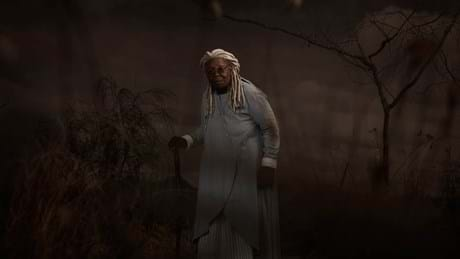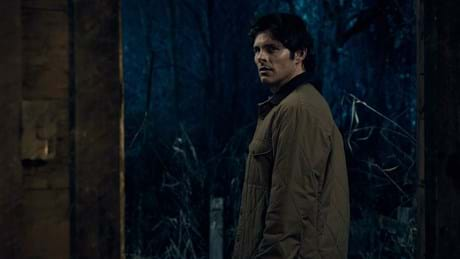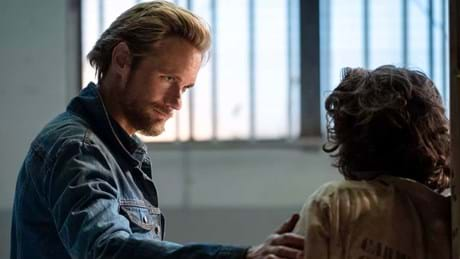New to Catch Up this month
07 July 2021DStv’s Catch Up service offers you TV in your own time, and there’s so much more to see on all packages this month.
The Stand’s series creators talk about how, even without the pandemic, Stephen King’s story feels fresh today. Watch it on M-Net (DStv 101).
A series about an apocalyptic pandemic feels a little on the nose right now. But the 2020 adaptation of horror author Stephen King’s 1978 novel, The Stand, starting on M-Net (DStv 101) on Monday, 18 January, uses his nightmare scenario of what would happen if 99,4% of the world’s population was wiped out suddenly, within two weeks, to ask some intriguing questions. It's framed in a battle between good and evil (personified in the story by the gritty but good Mother Abagail played by Whoopi Goldberg, and the seductively evil Randall Flagg, played by Alexander Skarsgård).
Series co-executive producer Taylor Elmore explains, “The Stand is ultimately a hopeful story and I hope that’s the way it plays. But three years ago, when I came on board this project, I thought The Stand was eerily relevant because it seemed to me that the people I knew had started asking questions we had grown up taking for granted about the structure of human civilisation and what makes a human society.
"What does society owe to the individual? What does the individual owe to society? What do we all owe each other? What if you got to press the reset button on humanity? Would you build back the same way? These really fundamental questions are central to the book. That’s why we wanted to tell the story even before there was any notion of an actual pandemic.”
Taylor Elmore, co-producer Benjamin Cavell, and one of the series leads, James Marsden (who plays hero Stu Redman, an ex-military man who starts the series being “kidnapped” by the government when he turns out to be immune to the virus), take us inside The Stand to share some of the background story…
Pre-production on The Stand started in 2018 and filming on the series started in September 2019 and ended on 12 March 2020. Exactly one week later, on Thursday, 19 March, the state of California went into lockdown to slow the spread of the COVID-19 pandemic.
James Marsden reveals, “We were in Vancouver shooting the show last September and started hearing about COVID in December, January and February. It wasn’t until the end of February that we started seeing masks popping up on set and hand sanitiser and everything. It was an eerie feeling. He [Stephen King] wrote the book in 1978, and it’s like he had a crystal ball. He’s always been curious about the choices humans make, and what gets under their skin and the psychology of good versus evil and what scares us. More than being a book about a pandemic, it has much more to do with the instincts of man and what we do in the face of this sort of apocalyptic crisis and what it reveals about ourselves. That’s the bigger story.
“It’s obviously something that’s on our mind, and it has been on our minds as we’ve cut the show over the course of basically the unfolding of the real pandemic,” says Taylor. “What we’re keeping focused on is that the book, The Stand, is about a pandemic at the beginning, then it’s about who we are in the wake of that pandemic.
"I think it’s more the second part of the story that we’re interested in. And then the pandemic we’re talking about is literally a weaponised murder virus that the government has engineered versus a naturally occurring virus. I think that distinction at least gives us a little bit of a remove from the realities we’re facing.” Ben adds, “We started shooting this in 2019 so in our universe, COVID is not a thing that has happened in the world.”
One of the major shifts from the book, which works brilliantly within the series, is that it jumbles the timeline. So while viewers will see what happened to different people during the early outbreak of the Captain Tripps virus (in around June 2020 within the world of the show), surrounded by the sick and dying, that’s intercut with their “now” as body crews dispose of corpses and people come together in temporary camps and try to puzzle their way forward. So the two different parts of the show work together in each episode.
The Stand has a cult following among Stephen King fans, something the production is deeply aware of. “The book is iconic for us. We know what it means to people. Members of the crew, our key grip and our lighting guys… our head lighting guy showed me a signed first edition of The Stand that he had!” says Taylor. “Everybody involved in the show felt this enormous responsibility to do it right.”
Not only is Stephen’s son, Owen, a writer and producer on the show, but the man himself also oversaw scripts. Taylor reveals, “We came aboard this project to do right by this masterpiece and by Stephen King. Having him there, knowing that he was reading every draft and signing off on everything – signing off on directors, actors. It was confidence-inspiring. He saw our first couple of drafts and was really enthusiastic. He said, ‘You guys clearly know the show you're making. Go on with your bad selves!’ which is a direct quote from his email. We knew that if we ever started to go too far afield, he or Owen would pull us back.”
Aside from having the author’s guiding hand, Ben, Taylor and their team also got access to Stephen’s brand-new reworking of his coda to the original book. While the revised ending is top-secret, Taylor hints, “What can we tell you about the new coda? Not much, but we can tell you that King had been planning this new ending for about 30 years. The genesis of it is that he’s very aware that Frannie [a survivor played by Odessa Young] doesn’t get her stand in the book. She is eight months pregnant when they leave to go on the stand to confront Flagg and she can’t go. She’s one of the main heroes of the novel, and that always felt to him like a piece of it that was unfinished. He has this lovely story that we get to end our story with that fixes this. It’s such an honour that he trusted us to tell it.”
There was some work to be done adapting a story that predates not only social media but the Internet itself. Taylor explains, “We set the task for ourselves that this series had to feel as grounded and real in 2020 as the book did in 1978. We didn’t want to avoid what it would mean for people to have social media, for people to have phones. Obviously, there would be a moment we knew when all that stuff would stop. But it was important to us from early on that this series, in every way possible, be grounded in our current reality of 2020, technologically, socially, in all ways, that we really embrace that and think about what the implications would be for how differently a pandemic might play out in the modern day compared to what it would have been in 1978.
“We did an enormous amount of thinking about not just how the pandemic would start to play out, but as the grids would collapse and social services would break down. What are the kinds of things that people would be thinking about in 2020? How would they be providing for themselves? So much work went into that. It may not be explicit, but pallets of bottled water and stuff like that are in people’s houses in Boulder [where Mother Abagail is based].
"We did an enormous round of research and figured out what people would be hoarding, what they would be distributing to each other, that they would collect all the generators in Boulder and bring them to a central hub and use all the generators to power that thing. If you wanted to live in houses, well okay, but you’d need to use candles and stuff because we need the generators. That kind of stuff gives you the texture of modern reality so you can feel, as you do reading the book, that you are immersed in this world and can imagine exactly this thing happening in front of you.”
Aside from updating these aspects, the writers also needed to adjust how the story itself is told.
Taylor reveals, “One of the things Stephen King does is the way that he writes is very internal. There are a lot of internal monologues, a lot of what people are thinking. When you pare down the actual action of what happens in The Stand versus what’s going on in the characters’ heads, it’s daunting, but not as much as it would appear. What’s daunting and tricky is getting all that subtext that’s on the page on an actor’s face in one second. You have pages to get there in a book. But we had exactly the actors to do that.”
Ben adds, “I’ve been on it for three years. It was a long process. Adapting a 1 200-page book requires an enormous amount of thought, especially when you’re interweaving two different timelines, which the book and the original [1994] miniseries don’t do. We were trying to jigsaw all that together, and have it feel satisfying and propulsive and visceral and dramatic.
"It was a long time and a lot of thought went into it. Wherever we deviate from the book, it's because we’ve made a choice to do it because it didn’t fit into the story we were telling or the way that we were telling it.”
The Stand’s villains, like Randall Flagg, and heroes like Stu Redman, are really going to hit home with audiences thanks to the original writing and the series’ adaptations.
Ben reveals, “It was important to us that Flagg not just be a kind of cartoon bad guy twirling his moustaches, and just be Eeeevilll with a capital E. It was important to us that we really say something and show something about the appeal of a Strong Man, of an authoritarian of that kind, and that we make him incredibly charismatic and beautiful like Alexander Skarsgård.
"It was important to us that it resonates with things that we are all going through in different parts of the world about the appeal of a certain kind of leader [you know who he’s talking about]. It was important to show that, ‘Oh, I can see myself, if I were in the circumstances that these people are in, in this world of chaos and danger where everything is incomprehensible – when there is a guy who is so beautiful and so charming and can levitate and who seems to have a handle on what all this means, on what’s going on, what’s really going on, that you might very well choose to follow that person.’ Of course, as the story goes on, I hope we as viewers and we as creators will start to realise that ‘this guy is not all that I had hoped’, that we’d start to see the cracks and see the ways in which he is completely whatever he is. We hope that is a way in which it resonates.”
James adds that in a world that’s getting a bit sick of its antiheroes, Stu Redman is the kind of hero he’d be looking for in a crisis – kind of an anti-Randall Flagg. “I love characters like Stu. I know being a good person and being virtuous is not always the sexiest or flashiest thing, and sometimes it can even be boring to watch. And when we go to Vegas, it’s a lot more fun to watch the Randall Flagg world. But I also think that in the face of real, humbling uncertainty and apocalyptic crisis, people want to lean on humans who have strong opinions on what is right and a dedication to restoring stability and using virtues like kindness and decency.
“That may sound kind of Milquetoasty boring, but I like to celebrate those characters. I feel we need more people like that in the world or we need to bring that out in more people because I do think that exists in everybody. He’s a reluctant hero. I don’t think he chooses to be the leader here. He’s a guy who’s simply trying to do the right thing because he’s got a strong moral code, strong values and believes in loyalty and respects authority, and he wants structure and craves order.
"So when Flagg comes along and he represents anarchy and chaos, it terrifies Stu. I like sometimes to play boring good guys who remain optimistic. I never want to get cynical in my life. We all have our dark sides and we all have our dragons that we wrestle with, but I like to celebrate the people who, when no one is looking, choose to do the right thing. I think Stu embodies that,” says James.
“Stu was this cowboy hero in the book and with our interpretation, we’ve made it less about the small-town cowboy who comes to save the town and saves the damsel in distress. We’ve dropped those tropes,” adds James. “Stu now is less of a hero riding in to save the day and more working in the shadows to bring people together to realise how powerful it can be if you work together as a community.
"There were moments when Stu was doing something in the book that was then given to some of our actresses. There was a bit of evolution in updating this. I don’t think anyone wanted to lean on the idea that Stu comes in and is the big cowboy hero who saves everybody.”
Of course, the Stu Redmans of the world fight their own internal battles. Part of what makes them heroes is that they choose not to shift their pain and conflict onto other people, which is a choice that we see other characters, like Harold Lauder (Owen Teague) make, which draws them into Randall Flagg’s world.
“It was clear to me what his virtues were, what made him a good man. I wanted to crack the surface and figure out what regrets he has, what mistakes he thinks he’s made – when he was seduced by the darker side and what that looked like. To balance it all out. You can’t play a character like this and have him be flawless. It would be so uninteresting to watch,” explains James.
“People have to want to relate to him and see he’s human. I wanted to dive into what makes him a good leader and what makes him a positive presence for everybody in Boulder, but also what he’s searching for in his life. If you go to the back story, he lost his wife, and in his formative years, I don’t think he was afforded the opportunity to dream big and have these big goals in his life, so he accepted this small-town life, but with dignity.
“Beyond that, I wanted to explore what his nightmare looks like, what stresses him out, what regrets does he have? That informs every decision he makes. If you set that foundation for the character, you allow the script to come to you and things sort of click into place. It’s important to me when you’re playing a guy who's a good guy to find a humanity in him outside of just trying to help people and save people. What challenges him?
“You have to take some creative licence and recognise that this is going to be your interpretation of the character. And it takes a firm understanding of what purpose the character serves in the story. And if you understand that, you can colour it however you want, within the creative latitude that you have as an actor to make it your own.
"We talked a bit about Stu having a little bit of humour and there are moments in the show where you can see him having a wry, sarcastic sense of humour that would sort of defy his good nature at his core. Stephen was just excited to have it back out there and gave his stamp of approval every day. His presence was felt because he was talking to the showrunners all along and knowing we had his approval, I wasn’t that nervous about it. But you do feel a certain amount of responsibility,” says James.
Watch The Stand S1 from Monday, 18 January, on M-Net (DStv 101) at 22:30 or on Catch Up


